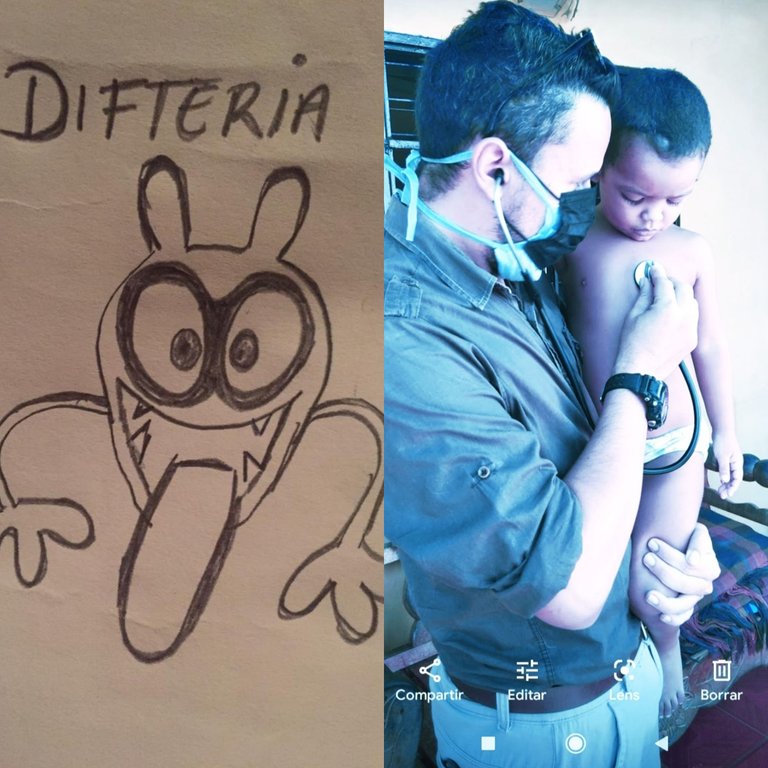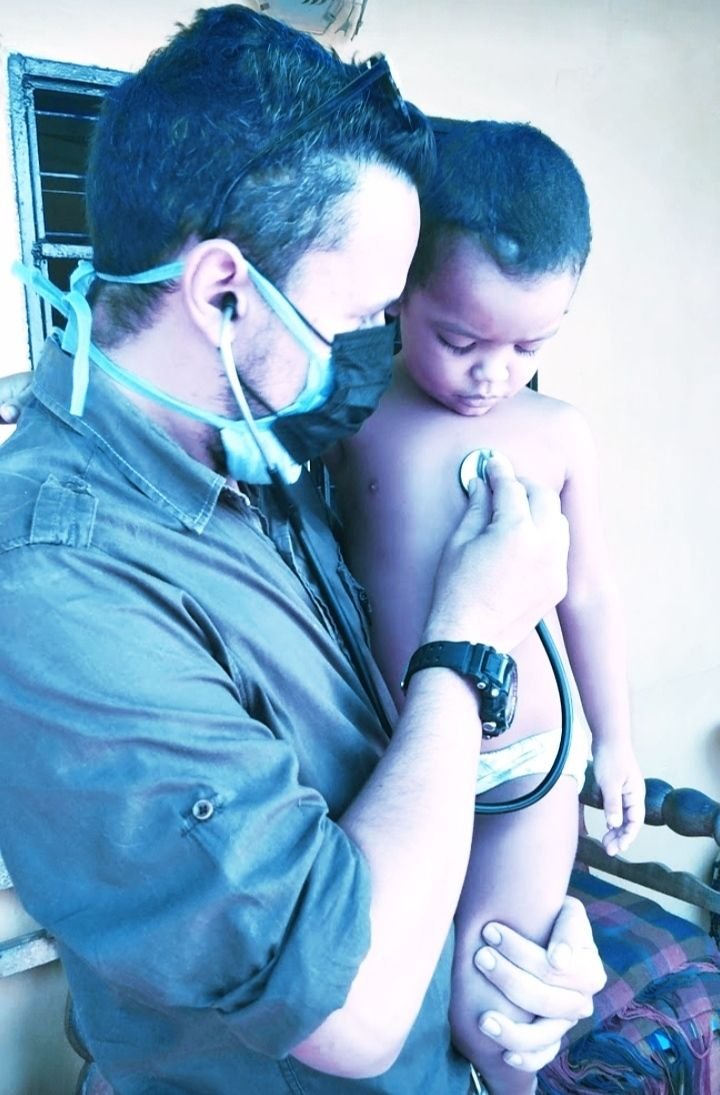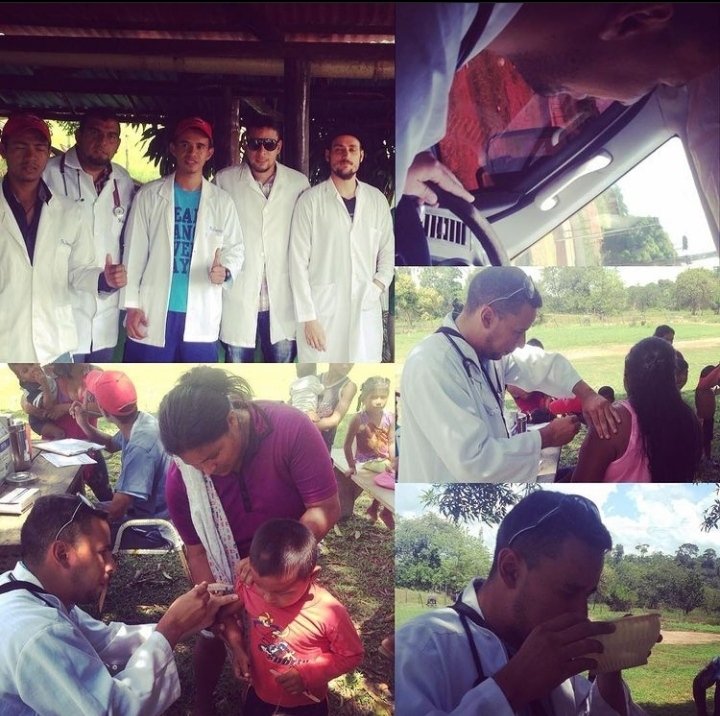Hivers!!! Un placer saludarlos, deseando como siempre vida y salud para ustedes y para quienes les rodean, eso siempre será el tesoro más preciado y el cual debemos conservar.
Por acá me encuentro, contento por la llegada de las lluvias a mi país Venezuela, que avisa la llegada del invierno, pues el verano estuvo intenso y la temperatura con frecuencia pasaba los 36 grados centígrados.
Ya para entrar en contexto hoy escribiré sobre Disfteria:

La Disfteria: es una enfermedad infecto-contagiosa producida por una bacteria, y es una de las tantas enfermedades que se pueden adquirir de forma aeróbica, por medio de las gotitas flügge.
Cabe destacar, que el agente causal de la difteria es Corynebacterium Diphtheriae un bacilo que afecta principalmente las vías respiratorias superiores sobre todo la nariz, garganta y laringe.
Es importante resaltar, que está enfermedad es de inicio brusco, acentuándose con el transcurrir de los días, los síntomas principales son: dolor en faringe, fiebre, adenopatías en la región de cuello, anorexia, escaalosfrios, disfagia (dificultad para tratar), erupción cutánea.

Sin embargo, está enfermedad no se puede descuidar bajo ninguna circunstancia, pues suele generar complicaciones que pueden llegar a comprometer la vida del paciente, ya que las toxinas emanadas por la
Corynebacterium Diphtheriae forman una capa de tejido muerto que causan una proliferación de bacterias y causa inflamación a nivel de la faringe producción dificultad para respirar.
De igual forma, las toxinas antes mencionadas pueden expanderse al torrente sanguíneo, y a través de el afectar el músculo cardíaco generando un infarto.
En función de lo antes planteado, es oportuno a acotar que la difteria puede afectar a hombres, mujeres y niños de cualquier edad, indiferentemente de su raza o condición social por su facilidad de transmisión, de hecho en el pasado fue muy común en niños.

Diagnóstico:
Definitivamente, en el diagnóstico de la difteria como en otras tantas patologías, tanto el interrogatorio como en examen físico juegan un papel importantísimo, y es que para diagnosticarla primero hay que pensar en ella.
Muchas veces está afección pasa desapercibida, pues se confunde con una amigdalitis común, generando un importante número de contagios y complicaciones.
Por eso hay que hacer énfasis en los antecedentes personales del paciente, dónde trabaja, a qué se dedica, que hace en su tiempo libre, y si tiene la vacuna contra toxoide y tétano. De igual forma mirar con atención las características de las membranas que invaden la faringe, fijándose en la coloración y tamaño.
Asimismo, los exámenes complementarios también sin importantes, la hematología completa nos reportará un aumento de leucocitos, a expensas de neutrófilos. Por otra parte un cultivo de C. diphtheriae, nos confirmará el contagio.
Tratamiento:
Actualmente la enfermedad planteada, se puede prevenir al 99,9 % por medio de la vacuna, la cual es realmente eficaz.
Sin embargo, en relación a posibles individuos contagiados, es importante acudir al médico oportunamente, quien indicará tratamiento inmediatamente, que comprende antibióticos y antiinflamatorios, además de aplicar la vacuna en cuestión de forma inmediata.
El médico tratante está en la obligación de notificar a las autoridades de salud correspondientes, ellos se encargarán de hacer un barrido epidemiológico en busca de posibles contagios.
Debo decir, que el año 2017, hubo una alta incidencia de casos en mi país Venezuela. En ese momento llevaba unos pocos meses de graduado, y fui seleccionado para viajar al epicentro del problema que se encontraba en el Estado Bolivar,
lugar que se encuentra a 20 horas (en carro) del sitio donde vivo.

Fui seleccionado en una brigada compuesta 100 médicos, de todo el país, fueron muchos los casos que tratamos, y mucho con desenlaces fatales, pero logramos el cometido, erradicar la enfermedad en ese momento.
Está experiencia fue única y marco mi vida de manera positiva, en total estuve 15 días entre pueblos y ciudades trabajando sin descanso en pro del bienestar de mi pueblo.

A Dios gracias por tan bonita experiencia.
Dios siempre de cabrestero.
PD: Fotos y Dibujo de mi Propiedad.
English:
Hivers!!! A pleasure to greet you, wishing as always life and health for you and for those around you, that will always be the most precious treasure and which we must preserve.
Here I am, happy for the arrival of the rains in my country Venezuela, which signals the arrival of winter, because the summer was intense and the temperature often exceeded 36 degrees Celsius.
Now to get into context, today I will write about Dysfteria:
Dysphtheria: is an infectious-contagious disease produced by a bacterium, and is one of the many diseases that can be acquired aerobically, by means of flügge droplets.
It is important to highlight that the causal agent of diphtheria is Corynebacterium Diphtheriae, a bacillus that mainly affects the upper respiratory tract, especially the nose, throat and larynx.
It is important to emphasize that this disease has an abrupt onset, becoming more pronounced with the passing of days, the main symptoms are: pharyngeal pain, fever, lymphadenopathy in the neck region, anorexia, scales, dysphagia (difficulty in swallowing), skin rash.
However, this disease cannot be neglected under any circumstance, as it usually generates complications that may compromise the patient's life, since the toxins emanated by the Corynebacterium Diphtheriae form a layer of dead tissue that causes a proliferation of bacteria and causes inflammation at the level of the pharynx producing difficulty in breathing.
Similarly, the aforementioned toxins can spread to the bloodstream, and through it affect the heart muscle causing a heart attack.
Based on the above, it is appropriate to note that diphtheria can affect men, women and children of any age, regardless of their race or social status because of its ease of transmission, in fact in the past it was very common in children.
Diagnosis:
Definitely in the diagnosis of diphtheria as in many other pathologies, both the interrogation and physical examination play a very important role, and is that to diagnose it you must first think about it.
Many times this condition goes unnoticed, because it is confused with a common tonsillitis, generating an important number of contagions and complications.
For this reason, it is necessary to emphasize the patient's personal background, where he/she works, what he/she does, what he/she does in his/her free time, and if he/she has been vaccinated against toxoid and tetanus. Also look carefully at the characteristics of the membranes that invade the pharynx, paying attention to the color and size.
Also the complementary examinations are also important, the complete hematology will report an increase of leukocytes, at the expense of neutrophils. On the other hand a culture of C. diphtheriae, will confirm the infection.
Treatment:
Currently, the disease can be prevented 99.9% by means of the vaccine, which is really effective.
However, in relation to possible infected individuals, it is important to go to the doctor in a timely manner, who will indicate immediate treatment, which includes antibiotics and anti-inflammatory drugs, in addition to applying the vaccine in question immediately.
The treating physician is in the obligation to notify the corresponding health authorities, they will be in charge of making an epidemiological sweep in search of possible contagions.
I must say that in 2017 there was a high incidence of cases in my country Venezuela. At that time I had been a few months graduated, and I was selected to travel to the epicenter of the problem which was in Bolivar State,
which is 20 hours (by car) from where I live.
I was selected in a brigade composed of 100 doctors from all over the country, there were many cases that we treated, and many with fatal outcomes, but we achieved the task, eradicate the disease at that time.
This experience was unique and marked my life in a positive way, in total I spent 15 days between towns and cities working tirelessly for the welfare of my people.
Thank God for such a beautiful experience.
God always of cabrestero.
Su post ha sido valorado por @ramonycajal
Excelente información doc 😉, saludos
Un saludo amiga.
Oye que bonito post, me gusto mucho leer tu anécdota con la difteria, esas son experiencias que uno atesora para siempre. Yo actualmente me encuentro haciendo el internado rural en el pueblo de Chuao y ha Sido toda una aventura tanto a nivel profesional como personal. Gracias por compartir la información y tú experiencia, saludos y un gran abrazo!
Hola Doc, que éxito que estés haciendo tu Art. 8 en ese pueblito mágico, estoy seguro que lo estás disfrutando mucho. Gracias por leerme, estaré pasando s visitarte (virtualmente). Bendiciones.